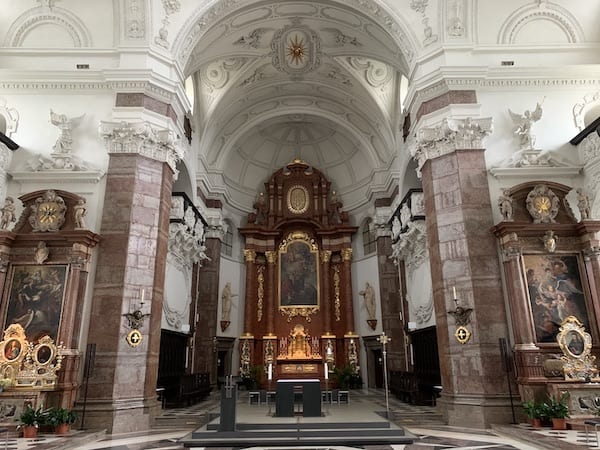St Peter Canisius and the Jesuits
St Peter Canisius and the Jesuits
Jesuits, Franciscans, Premonstratensians, Carmelites, Servites, Capuchins, Ursulines. Visitors to Innsbruck usually walk past many monasteries without realising it. The Jesuits were probably the most politically influential order in the history of the city. The "Soldaten Christi" were founded by the former nobleman and officer Ignatius of Loyola (1491 - 1556). Loyola was a moral reformer. Unlike Luther, he wanted to change the church, but not without the Pope as its head. In their zeal for reform, the Jesuits focussed on better training for the clergy and higher moral standards based on Christian roots in everyday church life. Their most important contribution was the founding of schools and universities. Protestant countries and cities had begun to German schoolsacademies and grammar schools. As many subjects as possible should be able to read in order to find piety and salvation in individual and direct Bible reading. The Jesuits, on the other hand, concentrated on educating the elite and thus gained lasting influence in the centres of power of the Catholic states. Not only aristocrats, priests and politicians, but also civil servants were educated in schools and colleges.
The Jesuits founded the Latin school in Innsbruck, from which the university would later emerge. The new school had a major impact on the city's development. The intelligentsia was educated here, enabling Innsbruck's rise as an administrative and economic centre. Its activities were interrupted under Joseph II. He disempowered and expropriated ecclesiastical orders, including the Jesuits, whom he had little love for. Under him, the University of Innsbruck was downgraded to a lyceum in 1781. It was not until 1838 that the Jesuits were reappointed to Innsbruck. In addition to professorships at the university, they had the Theresianuma grammar school for the aristocracy, in a leading role.
Thanks to the educational system, skilful structures, discipline and organisation adopted from the military, the Order grew rapidly and managed to establish a special relationship with the Habsburgs during the Counter-Reformation. Many members of the dynasty can be recognised in their rule and actions as having been influenced by the order from which they received their education. Jesuits such as Bartholomew Viller or Wilhelm Lamormaini were politically influential as confessors and advisors to the Habsburgs in the early modern period. It is no coincidence that the Jesuits are still the adversaries of the Freemasons in countless conspiracy theories and novels and are regarded by many as the modern-day equivalent of the James Bond villain.
A keen supporter of the Jesuits in Tyrol was the Tyrolean prince and later Emperor Ferdinand I. Like Ignatius of Loyola, he had grown up in Spain. He had just as many difficulties with the customs of the Germans and the non-existent Reformation movement in Spain as he did with the language. The Tyrolean population, on the other hand, were alienated from their sovereign, who, with his foreign court, could easily be mistaken for an occupying power. A connecting element between the two worlds was the Roman Church, especially the Jesuits.
The Jesuits were very open to research, knowledge gathering and education and wanted to learn to understand the world in terms of Christian creation. For Catholics, this made them a hip antithesis to both the dusty existing orders and the Protestants. Faith and empiricism combined to form a kind of pre-modern science that attempted to explain nature and physics. Ferdinand II's collection at Ambras Castle bears witness to the thirst for research of the time, as do the alchemical experiments carried out by Emperor Matthias.
For all their love of science, mysticism also returned to everyday church life under the Jesuits. Passion plays, Easter sepulchres, processions and feast days were intended to soften the strict principles of the faith with drama and spectacle. The Marian Congregation, known as the MK in Innsbruck in the 1960s and 70s, was one of the largest youth centres in Europe. In a modern sense, it can certainly be seen in the tradition of the Church's gentle introduction to the faith and the education of young people.
The Jesuit order, fully committed to popular belief, was also highly motivated when it came to persecuting witches and people of other faiths. In the then recently discovered New World in America and Asia, the Jesuits were eager to proselytise the local pagan population. St Francis Xavier, one of Ignatius of Loyola's first companions, died on a missionary journey in China. In a side chapel of the Jesuit church in Innsbruck, this Soldaten Christi an altar was consecrated.
One of the most important Jesuit theologians was Petrus Canisius (1521 - 1597). The educated cleric quickly rose through the ranks of the newly founded Jesuit order and was installed by Emperor Ferdinand as one of the most important ecclesiastical politicians in the empire. During his travels across Europe, Petrus Canisius also spent some time in Innsbruck and played a key role in the establishment of the Jesuit order. He was both a confessor to the aristocracy and a churchman for the masses, reaching out to the rural population while travelling through the villages of Tyrol. He recognised that Latin was not the language to immunise peasants, farmhands and maids against Protestantism. With his catechism, Petrus Canisius wrote an important German-language collection of ideas in the Catholic struggle against the Protestant Reformation, which was translated into all languages and was long regarded as a guide for the Catholic Church.
Today, Karl-Rahner-Platz is not only home to the Jesuit Church, but also the Faculty of Theology at the University of Innsbruck. In Saggen, the Collegium Canisianum belongs to the Jesuits.
Sights to see...
University of Innsbruck
Innrain 52
Collegium Canisianum
Tschurtschenthalerstrasse 7
Jesuit Church & Pfeifersberg Palace
Karl-Rahner-Platz / Sillgasse 6
